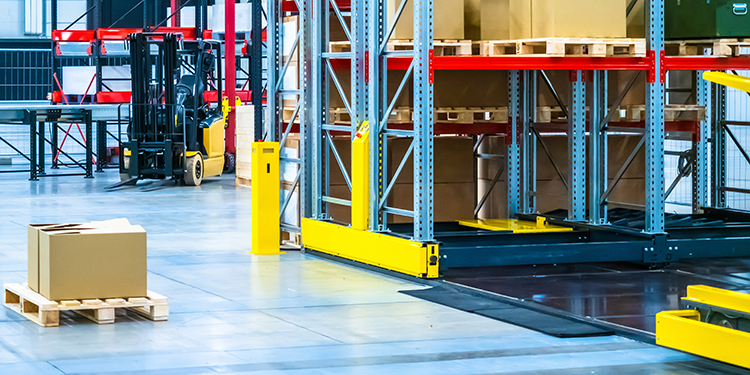How Rack Guards Protect Racking From Damage Caused By Forklift Collisions

Impacts from forklift trucks or other moving equipment are a major cause of accidental damage to industrial steel storage racks. Such damage — which occurs most frequently to the portion of the columns below the first level of beams — can significantly reduce the load bearing capacity of the total rack system, causing a serious safety concern. As it is neither practical nor affordable to design racks capable of resisting maximum impact forces, there are a variety of design options and guarding accessories available to limit the potential and severity of such damage.
During the design of the base rack system, the structure can be specified with larger and/or heavier rack columns, column reinforcements and inserts, heavier upright frame bracing, and different rack column shapes. These design options can increase the ability of the racking to resist impacts when it is first installed.
For existing systems, however, adding rack guards as a retrofit provides extra protection against damage from collisions. To limit the damage a forklift impact can cause, rack guards can be applied to two different areas of a structure:
- The ends of rack rows (including at cross-aisles and in rack tunnel bays).
- The aisle-side face of the rack column.
A variety of guards are offered for placement at the ends of rack rows. Common types include:
- Heavy, structural steel angles — measuring 3 inches wide x 5 inches (or more) high — with welded, formed ends that wrap around the rack columns. To attach the device, the horizontal leg of the angle is pre-punched to accept mechanical concrete anchor bolts.
- Pipe or tube that has been formed (or welded) into an inverted U-shapes. These tubes run the full depth of the rack assembly and are factory welded to the steel base plates are anchored to the floor.
- Free standing, industrial modular guard railing set a short distance away from the racking and is bolted to the floor. These are typically placed as close to the rack as possible in order to minimize intrusion into travel aisles.
- Guards that attach directly to the sides of the upright frames.
Guards to protect rack columns are applied to the aisle-side facing uprights. These include:
- Free standing column protectors, which are formed steel plates that wrap around the face and sides of the rack column. To secure them, the protectors are typically factory welded to steel base plates that are anchored to the floor.
- Steel, foam or plastic guards attach directly to the rack column with bolts, rivets or straps.
Before adding rack guards to an existing storage rack system, owners should consider the following when evaluating the different options.
- The thicker the steel used to construct the guard the more impacts it can withstand before failure. When comparing different products, be sure to assess the strength of the material.
- Examine the racking’s surroundings for potential installation issues. Most rack guards extend into the aisles or rack bay openings in one or more directions; it is important that their placement will not impede existing handling clearances.
- Confirm the position of the rack load beams, which may interfere with the guarding’s placement.
- For devices that wrap around rack columns, the size of the rack column’s baseplate must be considered to avoid interference.
Notably, although reinforced design options and rack guards improve rack safety by limiting forklift damage, it’s also critical to address the root causes. Among them: forklift driver training and management, rack system layouts with adequate operational clearances, clean and well-lit environments, and selection of options and accessories at the time the system is specified.
Looking for a list of the full range of protective accessories available for racking installations? RMI’s publication, “Considerations for the Planning and Use of Industrial Steel Storage Racks,” lists more than 20 different options in section 3.4.2.


